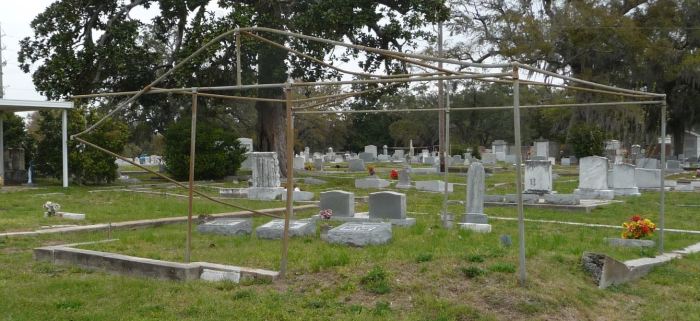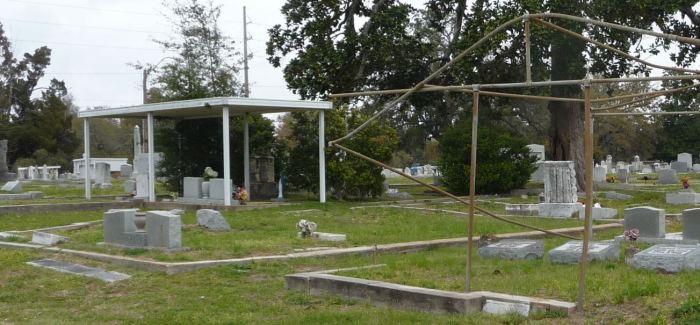A belated happy All Saints’ Day to you. If you’ve ever been through the Biloxi Cemetery you may have seen structures over plots that resemble a tent frame.
According to the 1938 WPA Guide to Mississippi the structures are…
“Probably unique among cemeteries of the world is the custom frequently used here of shading the graves with canopies of Spanish moss draped on bars a few feet above the headstones.”
A later edition concedes that these frames are probably not as unique as was claimed in the first edition, stating…
“Here the custom of using Spanish moss as canopies for the graves prevails. On All Saints’ Day Catholic families supplement the moss with flowers according to the religious custom of Latin countries.”
The Latin countries the guide is likely relating to are the Latin Union countries of France, Belgium, Switzerland, Italy, Greece, Serbia, Romania, and Spain, rather than the Central and South American countries commonly referred to as Latin today.
The canopies are made from 1/2 galvanized iron pipe and steel wire. No two appear identical, varying from plain to elaborate, with the only limitations being those of galvanized iron pipe.
In all my time in Biloxi I have never see bars wrapped with Spanish Moss. But there are several modern equivalents that appear to use prefabricated carport parts. These permanent covers eliminate the need for gathering Spanish Moss. Is this a tradition that is observed in other parts of Mississippi? Does your local burying-ground have a unique tradition?
Categories: Biloxi






Very interesting! This is a new one for me, and I have never seen these structures before.
LikeLike
I’ve never seen this either. It reminds me of a cemetery in Lauderdale Co where I’m told there were little wooden house like structures over many of the graves that have since rotted away, leaving nothing marking the graves. I did find a photo of one so its not just legend. I’d share but it’s been a few years and I don’t know what I did with the photo.
LikeLike
The WPA guide does mention some “graves covered by small wooden sheds” in Lawrence County. If these coverings are in Lauderdale County also perhaps the moss draped canopies are a coastal twist on a wider tradition?
https://archive.org/stream/mississippiaguid00writmiss#page/450/mode/1up
LikeLike
Those structures are very similar to the ones in Lauderdale Co. I’ve been in many cemeteries in Mississippi though and I’ve never actually seen any though. I wonder if this was more common than it seems and they’ve just all rotted away. The structures in Biloxi have just lasted longer due to their composition. I wonder how old they actually are.
LikeLike
Good question. The Biloxi structures are worthy of inventory. I’ve never seen a date on a canopy during casual observation. Maybe a cross reference with the dates of the interred might be a place to start.
LikeLike
Good point.
Btw, I think the WPA photo was taken in Jones Co., or maybe Covington. Sounds like it’s between Laurel and Collins. Is there a second one or is that a mistake?
Love the WPA guide! I may have to take one of their “tours” sometime. That one wouldn’t be too far of a drive for me and I’d like to see where those “sheds” were located.
LikeLiked by 1 person
Are Hebron and New Hebron the same place? I thought the graveyard may have been between New Hebron and Collins.
It would be a fun activity to see how closely one could follow the tours and see what has or has not changed.
LikeLiked by 1 person
Are you volunteering to retrace that tour and create a post or two or three about what you find? :-)
LikeLike
And there you go, another new series for MissPres: WPA Tours: Then and Now.
LikeLike
Great minds think alike! I’ve been sitting with my WPA Guide in the last week thinking, “how could we repost these as a serial?”
LikeLike
Right after I finish my Malted Milkshake tour. :)
LikeLike
After doing some googling, I can’t find a good source for exactly where Hebron, MS is located, but there are several links with maps, including a Hebron Cemetery in Jones Co. on findagrave, that place it right in the middle between Laurel and Collins. That makes sense since the last larger town on the tour is Laurel and the next is Collins. It also says Hebron was the home of Newt Knight which would place it in Jones Co too.
I’m definitely going to attempt this tour as soon as the semester is over and I have time.
LikeLiked by 1 person
Excellent! Please let us know what you find.
I did find Hebron. It is on HWY 84 and Hebron Centerville Rd., right on the Jones County line.
Maybe this 1938 highway map will be helpful?
Click to access HWY%20Map%201938%20Road%20Map%20of%20MS.pdf
LikeLike
Awesome map!
Thanks! I’ll be happy to report my findings.
LikeLiked by 1 person
Thanks. Happy (late) Halloween to you too. & an (early) Happy Thanksgiving too. Sylvia
LikeLike
While I do not have any information about these Biloxi cemetery canopies, as others have pointed out, Biloxi is not the only place that you can see similar structures. Grave houses were a somewhat common folk tradition, perhaps a rural take on a mausoleum. “Tributaries: Journal of the Alabama Folklife Association: No. 3” has an article on grave houses (mostly concentrating on Alabama but looking at grave houses as a Southern regional phenomena).
I am rather surprised that among the commenters on Preservation in Mississippi I am the only one who has seen a wooden grave house in person. I have seen two, both in quite poor, rural areas. One was in Marion County, Alabama and the other was in Franklin County, Alabama. Both are remarkable survivors as, since they are made of wood, both require upkeep from family members (rural cemeteries have no sextants obviously), are subject to weathering, and are always in danger of rural vandals burning them down during a night of cemetery destruction. Since the tradition of building grave houses disappeared many decades ago, both grave houses are quite old.
The best places to probably find grave houses in Mississippi are in the northeastern hill country and the piney woods. I imagine there might be a few remaining in Itawamba, Tishomingo, and Prentiss in the northeast and some in Jones, Wayne, Jasper, Clarke, etc. Perhaps finding the remaining Mississippi grave houses is a project that the MDAH could undertake. It is a rare folk form that has nearly completely vanished and is worthy of preservation.
If I could find my photographs and information on the grave houses I have seen, I might post it here. Until then, here is a link to some grave house photographs taken by HABS in Alabama. http://tngenweb.org/darkside/grave-house-2.html
LikeLike
The Marion County cemetery I referred to in my previous comment is the Goggans Cemetery. I took some photographs of it and its grave house in August 2008.
LikeLiked by 2 people
Fascinating! I’ll have to track down a copy of that article.
Are the graves relatively normal other than the houses? A stone headstone?
LikeLike
Yes, the two headstones in the Goggans Cemetery grave house are marble obelisk-like stones (they are not obelisks but that is the closest comparable shape I can think of to refer to them), fairly typical for late Victorian-type stones. You can see the finial top of one of them peeking over the fence on the right side of the grave house. The stones are not, in this case, a folk form. They conform to normal, mainstream design practices of the time. Since they have been protected from weather and lichen, they are in very nice condition. I was too impressed with finding a grave house to photograph the headstones’ inscriptions, so I am not sure who is buried there (other than some member of the Goggans family).
LikeLike
This has become even more interesting–thank you for the link and the photograph.
LikeLike
I spent a little time roaming yesterday, and there are actually quite a few cemeteries in Mississippi with gravehouses, and I am going to try to locate some of them in the next few weeks. Interesting subject!
LikeLike
Interesting, never seen anything like this. Is it just me, or are the “structures” on the coast quite tacky?
LikeLike
Are you referring to these funerary structures, or all structures on the coast? Could you elaborate?
LikeLike
I don’t attempt to answer for Mr. Nickens, but I did locate some interesting information while researching a future post on gravehouses after becoming interested in the genre because of this post.
Bridget Heneghan provided some insight about the picket fence (seen in the photo above) as an example of the “middle-class mark of refinement” that may have been symbolic to some families.
LikeLiked by 1 person
Greece is not Latin nor is Serbia.
LikeLike
They were members of the Latin Union, which is what the post referred to.
LikeLike
Here is a link to an al.com article by Kelly Kazek about the Airmount Grave Shelter near Thomasville, Alabama, a gravehouse of unusually high quality and uncommon construction methods: https://www.al.com/life/2020/11/this-grave-shelter-in-alabama-is-noted-for-unusual-size-architecture.html. I am not aware of any other gravehouse with a spraddle roof nor vaulted interior ceiling, and its brick construction is also quite uncommon. Airmount can almost be seen as occupying a middle ground between gravehouse and mausoleum. Unlike many other gravehouses, Airmount is in excellent well-maintained condition.
LikeLiked by 1 person